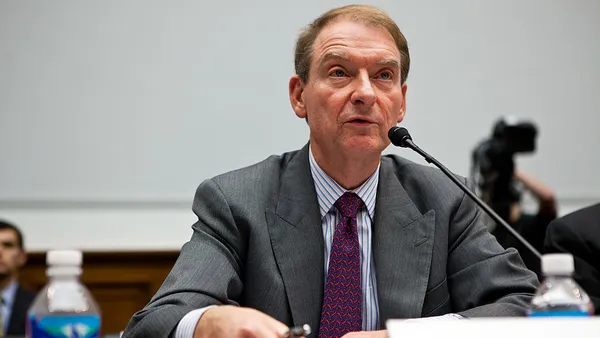Dive Brief:
- CFOs have trimmed plans for capital expenditures, with the share of financial executives citing unfavorable financing rising to 24% in the first quarter from 14% in the third quarter of 2022, according to a quarterly survey by the Federal Reserve Banks of Richmond and Atlanta.
- During the past three months the share of firms that cut spending, excluding capital expenditures, rose to 23% in the first quarter from 18% in the fourth quarter, the Fed regional banks said Wednesday, describing a survey conducted with Duke University’s Fuqua School of Business. The survey of more than 250 CFOs closed on March 10, the day Silicon Valley Bank collapsed, triggering turmoil in the banking system.
- Even before the bank failure, the outlook for business spending “deteriorated somewhat,” the survey sponsors said in a statement. At the same time, CFO optimism about economic growth was slightly higher before March 10 than during the fourth quarter while still well below the historic average, they said.
Dive Insight:
Turbulence in the banking system may prompt a tightening of credit similar to an increase in the federal funds rate, Fed Chair Jerome Powell said March 22 after policymakers announced a quarter percentage point hike in the federal funds rate despite the biggest banking crisis since 2008.
Several economists have aligned with Powell’s comments. Tougher lending standards may slow economic growth by half a percentage point, impeding the expansion by as much as a quarter-point or half-point increase in the Fed’s benchmark rate, according to Goldman Sachs.
“I give the Fed credit in the statement last week for acknowledging that what we’ve seen in banking — are likely to see — is going to tighten financial conditions,” former Fed Vice Chair Richard Clarida said Wednesday. “Financial conditions were tightening before [the failure of] SVB.”
Even some stable, well-capitalized banks will probably curtail lending, he said at a panel discussion sponsored by the National Association for Business Economics.
“You’ve got a whole category of institutions that are fine, they’re profitable, but they are either being encouraged, or have found religion, and they’re going to raise liquidity and have a high chunk of liquid assets,” Clarida said. “And the most straightforward way to do that is just to slow the growth in your loan book.”
Expectations for a decline in credit have solidified recession forecasts that preceded the failure of SVB and two other U.S. banks. Fannie Mae economists believe reductions in lending by small- and mid-sized banks, along with sagging confidence among businesses and consumers, will likely lead to a downturn.
Still, “it is too soon to determine the extent of any pullback” in lending and credit, Brent Meyer, assistant vice president and economist at the Atlanta Fed, said in response to email questions.
“One aspect of these recent events that could potentially exacerbate spending conditions would be if worries over banking conditions and potential financial stresses caused CFOs to shift to a risk-off mindset,” he said. “But that is not something we’ve seen so far.”
Two out of three CFOs surveyed in the fourth quarter said that the Fed’s most aggressive monetary tightening in four decades had not prompted a reduction in business spending, Meyer said. “The current quarter results suggest that those views may be starting to change.”
CFOs should consider ensuring access to credit by preparing detailed, monthly financial management accounts and closely tracking their cash flow needs, including maintaining a rolling cash flow forecast, according to Pamela Phillips, director of de Jong Phillips, a U.K.-based accounting firm.
“Lenders will be reassured that you have good financial control if, when they ask for your latest financials, you send them a current report and it is clear that you already have this in hand, rather than scrabbling around to pull something together just for them,” she said.
CFOs should plan for a variety of scenarios, considering variables such as the path of interest rates, the impact from any loss of key customers and access to funding sources, Phillips said in an email response to questions. They should also maintain a six-month cash buffer.
“The turmoil is sinking those businesses that were not well prepared,” she said. “Those that have good planning, cash buffers and critically review their numbers regularly are in a better place to ride out this storm.”














